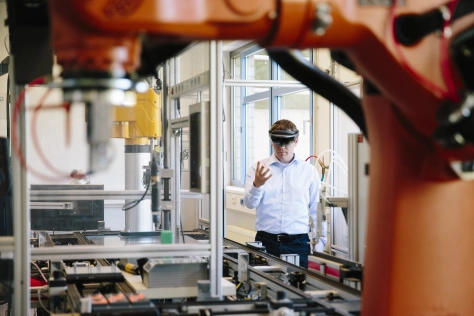
Thought leadership for transformation
Learn more about how we're helping our clients anticipate what's next.
The excitement around artificial intelligence (AI) tools sparked by OpenAI’s release of ChatGPT has been nothing short of monumental, gaining more than 100 million subscribers in just over its first two months.
ChatGPT combines an easy-to-use chat interface between the user who has a question (known as a “prompt”) and a large language model (LLM) that understands the question’s context and predicts the next word in a dialog with a human. While generative pretrained transformer (GPT) models have been in the works for quite some time, OpenAI’s release of a free, public and easy-to-use chat style interface triggered the rush for widespread adoption.
The outcomes astonished early testers and adopters who experienced its potential for achieving fast results for typically mundane tasks.
With the onset of this “AI momentum,” companies now find themselves wondering how AI could potentially fit within their organizations to help drive and propel business strategies and goals. One option to consider is how operational environments could expedite redundant processes and tedious tasks. In other words, “How can my company use AI to get through my daily to-do list faster and more effectively?”
In the technology field, it was quickly discovered that a key strength of this tool was writing source code for applications. Microsoft, for example, released Copilot for GitHub to assist developers using Visual Studio environments write applications in the code editor while they type. Copilot’s ability to understand the existing code helped developers on projects that had customized code already in place, potentially reducing the time for building applications and rapidly understanding the coding patterns for existing components.
AI’s capabilities extend beyond text, reaching into image generation with AI models such as DALL-E 2, which allows a text prompt to automatically generate photorealistic images. Midjourney enabled AI-generated images, allowing anyone to test a limited number of text-to-image generations for free.
Other image tools quickly followed, including Microsoft Designer, Bing’s Image Creator, Adobe Firefly and Stable Diffusion’s Dreamstudio, to name a few. OpenAI and others are also slated to introduce multimodal models that will combine text and image generation into a single prompt and output thread.
Worried that AI may replace humans? Don’t be! Everything we’ve seen so far has indicated that ChatGPT will still require a human in the loop (HITL). While these new iterations have fantastic capabilities, they don’t operate well without the right questions and iterations.
“Prompt engineering,” the mastery of how to ask the right questions or to craft prompts, is specifically dependent on human input and facilitation. Users can provide ChatGPT a training example of an ideal output (or “shot”) to enhance GPT’s understanding of a “successful” result using prompt optimization techniques.
We can even ask ChatGPT to provide its own best prompt for a given scenario. There’s also a wave of automations and plug-ins around ChatGPT that simply answer a question and provide tools and application recommendations for execution.
Hugging Face GPT, for example, enables users to develop a complete set of tasks and execute them across multiple applications. Microsoft has also previewed Jarvis as an opensource project on GitHub, a multimodal prototype that connects to multiple AI models, to automate the desired tasks using Hugging Face GPT. Support for plug-ins to external applications in Bing, Edge and visual chat (with multimodal search capabilities) are also included.
Microsoft’s early market lead and initial investment in OpenAI has substantially influenced AI technologies’ momentum and widespread adoption. Microsoft helped fuel this early excitement by enabling the rapid release of ChatGPT functionality into its Edge browser using its Bing search engine.
The releases of Microsoft Teams Professional and Viva Sales, which incorporated AI directly into Microsoft applications, soon followed. Teams Professional will use its meeting transcript functionality to automatically summarize the key points discussed with the list of actions and responsibilities for completion.
Microsoft is far from done, recently announcing, and demonstrating” Copilot for Microsoft 365,” a new AI-powered “assistant” that incorporates AI into Word, PowerPoint, Excel and other solutions that we use every day.
One of Microsoft's biggest AI initiatives is embedding AI into Microsoft Dynamics 365 Copilot for Business Applications that span Dynamics 365 Sales and Viva Sales, Dynamics 365 Customer Service, Power Virtual Agents, Customer Insights and Marketing, as well as supply chain applications.
Although OpenAI and Microsoft have a clear lead in market release, others are now fully in the mix. And AI momentum continues to grow. Anthropic with its Claude LLM, Google with Bard and Amazon Web services with Bedrock Stability.ai with Stable Diffusion all are growing their presence in the AI space – and there will no doubt be many more to come.
Thousands of start-ups surrounding these technologies are following suit, and while it may be tempting to evaluate the wealth of innovative ideas and tools to come, this landscape can be difficult and overwhelming to navigate.
Learn how Mazars can help maximize your potential with SAFE AI Framework.
The information provided here is for general guidance only, and does not constitute the provision of tax advice, accounting services, investment advice, legal advice, or professional consulting of any kind. The information provided herein should not be used as a substitute for consultation with professional tax, accounting, legal or other competent advisers.
This website uses cookies.
Some of these cookies are necessary, while others help us analyse our traffic, serve advertising and deliver customised experiences for you.
For more information on the cookies we use, please refer to our Privacy Policy.
This website cannot function properly without these cookies.
Analytical cookies help us enhance our website by collecting information on its usage.
We use marketing cookies to increase the relevancy of our advertising campaigns.